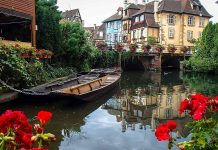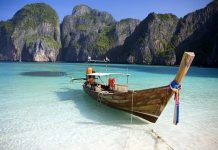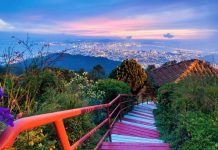
India’s Golden Triangle: A Kaleidoscope of Delhi, Jaipur & Agra
India’s Golden Triangle is one of the most iconic travel circuits in the world, offering a mesmerizing blend of history, culture, and architectural grandeur. Connecting the three legendary cities of Delhi, Jaipur, and Agra, this route forms a perfect triangle on the map, showcasing the very essence of India—from Mughal splendor and Rajput valor to bustling bazaars and timeless traditions.
Whether you’re a history buff, a culture enthusiast, or a lover of vibrant street life, the Golden Triangle promises an unforgettable journey. Let’s explore what makes each city a jewel in this dazzling circuit.
1. Delhi: Where Ancient Meets Modern
India’s capital, Delhi, is a city of contrasts—where medieval monuments stand alongside sleek skyscrapers, and labyrinthine old alleys coexist with sprawling metro networks.
Must-Visit Attractions in Delhi:
- Red Fort (Lal Qila) – A UNESCO World Heritage Site, this 17th-century Mughal fortress is an architectural marvel built by Emperor Shah Jahan. Its massive red sandstone walls enclose palaces, gardens, and museums.
- Qutub Minar – The tallest brick minaret in the world, this 73-meter tower is a masterpiece of Indo-Islamic architecture, surrounded by ancient ruins.
- Humayun’s Tomb – A precursor to the Taj Mahal, this stunning Mughal mausoleum is set in lush gardens and showcases Persian-inspired design.
- India Gate & Rajpath – A war memorial honoring Indian soldiers, surrounded by grand government buildings and vibrant evening crowds.
- Chandni Chowk – Delhi’s oldest and busiest market, where you can savor street food like parathas, kebabs, and jalebi while exploring spice lanes and historic havelis.
Cultural Experiences:
- Attend a Sufi music session at Nizamuddin Dargah.
- Explore the artsy lanes of Hauz Khas Village.
- Visit the Lotus Temple, a stunning Bahá’í House of Worship.
2. Jaipur: The Pink City of Royalty
The capital of Rajasthan, Jaipur, is a regal city painted in terracotta pink, a color symbolizing hospitality. Founded in 1727 by Maharaja Sawai Jai Singh II, it’s a treasure trove of palaces, forts, and vibrant markets.
Must-Visit Attractions in Jaipur:
- Amber Fort – A majestic hilltop fortress with mirrored halls, intricate frescoes, and elephant rides leading up to its grand gates.
- Hawa Mahal (Palace of Winds) – An iconic five-story facade with 953 jharokhas (windows), designed for royal women to observe street festivities unseen.
- City Palace – A blend of Rajput and Mughal architecture, housing museums, courtyards, and the royal family’s private residence.
- Jantar Mantar – A UNESCO-listed open-air observatory with colossal astronomical instruments.
- Nahargarh & Jaigarh Forts – Offering panoramic views of the city and home to the world’s largest cannon.
Cultural Experiences:
- Shop for handicrafts, jewelry, and textiles at Johari Bazaar and Bapu Bazaar.
- Enjoy a traditional Rajasthani thali at Chokhi Dhani, a cultural village resort.
- Witness a sunset at Jal Mahal, a palace floating on Man Sagar Lake.
3. Agra: Home of the Taj Mahal
No trip to India is complete without visiting Agra, the city that houses the Taj Mahal—one of the Seven Wonders of the World. A symbol of eternal love, this white-marble mausoleum was built by Emperor Shah Jahan for his beloved wife Mumtaz Mahal.
Must-Visit Attractions in Agra:
- Taj Mahal – Best visited at sunrise when the marble glows golden, this UNESCO masterpiece is an architectural symphony of Persian, Islamic, and Indian styles.
- Agra Fort – A massive red sandstone fortress that served as the Mughal Empire’s seat of power, offering stunning views of the Taj from its balconies.
- Fatehpur Sikri – A deserted Mughal city near Agra, featuring the grand Buland Darwaza and the mystical tomb of Sufi saint Salim Chishti.
- Mehtab Bagh – A serene garden complex across the Yamuna River, perfect for a peaceful Taj Mahal view away from crowds.
Cultural Experiences:
- Explore Kinari Bazaar for souvenirs like marble inlay work and leather goods.
- Taste Agra’s famous petha (sweet candy) and Mughlai cuisine.
- Attend a light-and-sound show at Agra Fort narrating Mughal history.
Best Time to Visit the Golden Triangle
- October to March – Pleasant weather, ideal for sightseeing.
- Avoid April to June (extreme heat) and July to September (monsoon rains).
Travel Tips for the Golden Triangle
✔ Transport: Opt for private cars, trains (like the Gatimaan Express for Agra), or domestic flights between cities.
✔ Guides: Hire licensed guides at major monuments for deeper insights.
✔ Dress Code: Modest clothing is recommended, especially at religious sites.
✔ Bargaining: Common in markets—negotiate politely for the best prices.
Conclusion: A Journey Through Time
The Golden Triangle is more than just a tourist route—it’s a passage through India’s soul. From Delhi’s imperial grandeur to Jaipur’s royal opulence and Agra’s timeless romance, this circuit leaves travelers spellbound. Whether you’re marveling at the Taj Mahal’s symmetry, getting lost in Jaipur’s bazaars, or relishing Delhi’s street food, every moment is a brushstroke in India’s vibrant canvas.
Pack your bags and embark on this unforgettable adventure—the Golden Triangle awaits! 🌏✨





















